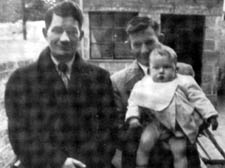
Peter Tyrell left, picturted here with his brother and nephew |
A tragic tale from Ireland’s dark history
The chance finding of a memoir has unlocked the mystery of one man’s terrible suicide on the Heath, writes Peter Berresford Ellis
Founded on Fear – Peter Tyrrell.
Edited and introduced by Diarmuid Whelan, foreword by Patrick Galvin, Irish Academic Press, Dublin, £15.95. order this book
ON April 26, 1967, the body of a man was found on Hampstead Heath. It was charred and burnt beyond recognition. Initial investigation found that the man had deliberately set fire to himself – a terrible act of self-immolation.
Who was this man and why had he committed suicide in such a way? The only clue was torn fragments of a postcard found near the body with the name ‘Dr Sheehy SK… Trinity College, Dublin’.
Dr Owen Sheehy Skeffington (1909-1970), a former Irish Senator (1954-1961), was a lecturer in French at Trinity College, Dublin. He was the son of the famous pacifists and socialists Francis and Hanna Sheehy Skeffington.
Owen shared his parent’s passion for human rights. As a senator he had campaigned to end corporal punishment in Irish schools, bringing to light some of the horrendous beatings taking place.
He was able to identify the suicide as Peter Tyrrell, originally from Cappagh, County Galway, who had been a victim of the institutionalised abuse that was taking place in the Industrial Schools run by the Christian Brothers.
Peter first contacted the then Senator in 1958 with his story. Sheehy Skeffington had persuaded him to write it down. Peter produced a 70,000-word manuscript. Founded on Fear is that story. It was recently rediscovered among Sheehy Skeffington’s papers and is finally published, edited and introduced by Dr Diarmuid Whelan of University College, Cork, and with a foreword by Patrick Galvin. It is a tough story and one told with heartbreaking honesty.
Peter was born in 1916, one of ten children, into a farming family. His father was lazy and impecunious. His mother had to resort to begging and the parish authorities swooped, putting six of the children into care. Aged eight, Peter was sent to St Joseph’s Industrial School at Letterfrack and left to the tender mercies of the Christian Brothers.
The experience – violent beatings for no provocation at all –
devastated him and he developed into a manic depressive. Peter left Ireland, aged 19, and arrived in London looking for an older brother. Without money and unable to find the brother, Peter found the only way out of sleeping on the streets was to join the British Army.
He found the security of institutionalised army life fitted his needs. He served in Malaya, Palestine and India. During his time in the army, however, Peter suffered periods of depression and, at one time, he was hospitalised because of it. But it seemed that the army doctors did not pick up on the long term cause and effects. It was clear in retrospect that Peter was suffering from manic depression.
His regiment was sent to Holland in 1944 and Peter found himself on the front lines. In January, 1945, he was wounded in his right arm and both legs, and taken prisoner. As a prisoner of war he was sent to Stalag XIB at Fallingbostel where he recovered and was eventually liberated.
In December, 1945, he was demobilised and arrived in London – a war hero but greeted with little respect by the country he fought for. His reception was brutal. This is where Peter’s story begins its path towards his suicide.
He arrived in London where “most landladies simply shut the door in my face when they knew I was Irish”.
I, too, remember London at a later period, 1964, with notices “No blacks, no dogs, no Irish” in rooming house windows. Peter managed to get digs in Camden Town where there were six or seven Irishmen to a room. Some in these overcrowded conditions, like Peter, had been former prisoners of war.
Work was difficult to come by. Frequently Peter had to change jobs because of anti-Irish prejudice and insults.
Hearing of a campaign to stop corporal punishment in Irish schools, Peter began to write to politicians, church leaders and newspapers to tell them of his experiences. His story was dismissed or, it was said, there was nothing they could do.
Senator Sheehy Skeffington was an honourable exception.
He encouraged Peter to write his story and helped him publish an article in the Irish magazine Hibernia in 1964. The senator also used information that Peter had given him in his own campaigns and in a pamphlet.
Peter, however, found that that most Irish people did not want to know, the Church closed ranks and the politicians supported them. Only 40 years later has the truth been accepted.
It is too late for Peter whose tragic suicide could have been prevented. He was betrayed – betrayed by the exponents of his religion, betrayed by the state which had promised to cherish all its children, and betrayed by the national psychosis which gripped Irishmen following the traumatic events of 1916-23. They closed their minds to all criticism of the new state and its ‘special relationship’ with the Church.
The changes in Ireland came too late for the likes of Peter but his story should be remembered as an indictment of the pettiness of human beings and the inhumanity which can arise when church and state walk hand in hand. This is a book that must be read.
|



